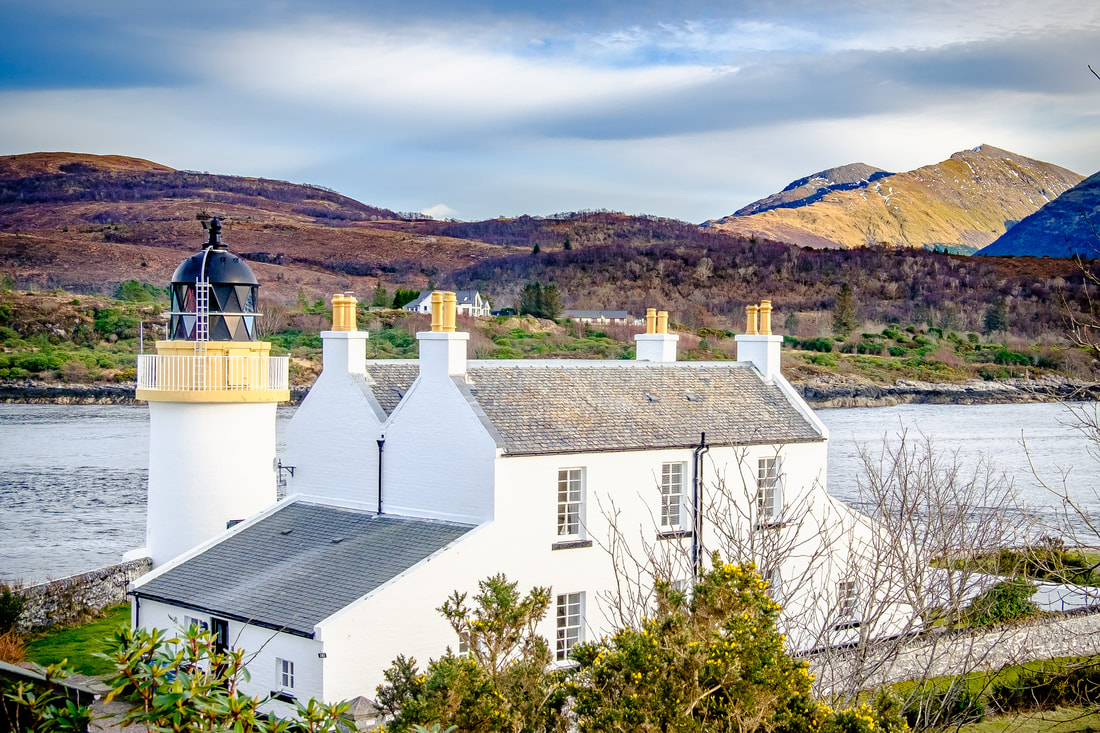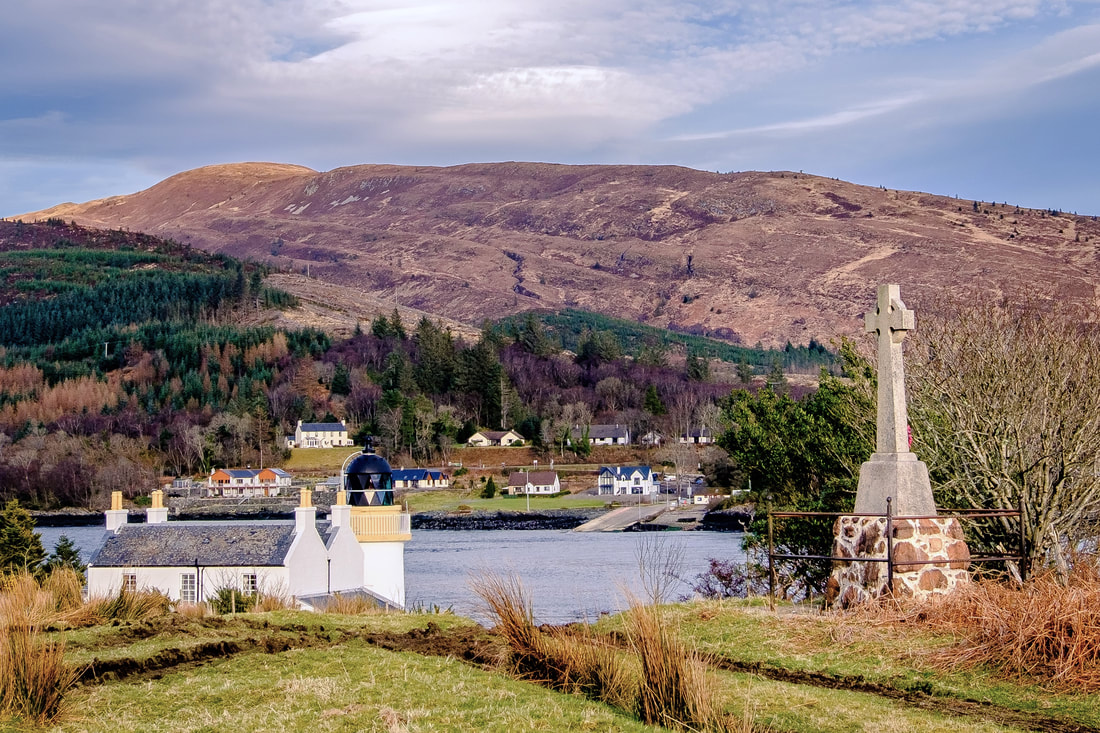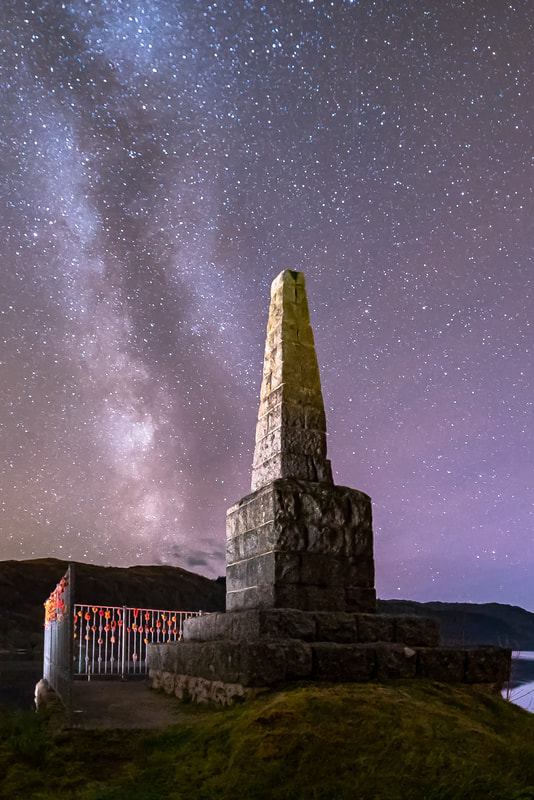|
With some time to spare after travelling back across the Corran Narrows on the ferry, I found myself up at the Ardgour War Memorial looking at signs of something that had gone before which had been a small part of a huge military project that is thought to have played a key role in bringing World War I to an end …. Time on my HandsLast week, I found myself with an unexpected hour or so to spare at Corran Point, so decided to go for a walk and find the Ardgour War Memorial, which is located up on a bank just south of the lighthouse and above the road. The main reason for doing this was to scout out the location in advance of me going there at some point after dark to photograph the Memorial under the stars. This is something that I do when preparing for most of my night shots as it is so much easier to figure out a composition in daylight than it is in the pitch dark. Having walked from the Corran Ferry, I reached the bend in the road by the Lighthouse and followed a track up into a field beyond a metal gate. I found the War Memorial at the top of a bank overlooking Loch Linnhe, with expansive views all the way down its full length to the south. The Memorial itself is typical of the many that you find scattered across the Highlands, consisting of a granite Celtic cross and plinth mounted on a base of what seemed to be made of local stone.
Gradually, I began thinking ahead to my future shot of the War Memorial under the stars and, eventually, I began looking at different shot angles of the Memorial to see if I could find some compositions that might work for the photograph that I had in mind. My plan is to take it later in the year when the Milky Way will be at its best, with its cloudy core above the horizon in the south to south-west sky. My aim is to produce something similar to these two shots that I’ve taken of the Strontian and Moidart war memorials in previous years. While doing this, I noticed that the Memorial’s stone base was sitting on what appeared to be a metal ring with several bolts protruding from it. You can see the metal ring and bolts in the picture below and the more that I thought about them, the more I couldn’t help wondering what they had been used for. Playing on My MindThis played on my mind for a day or two, leading me to do a bit of research to find out more about them. After looking at a few sources, I found some information in the Highland Historic Environment Record, that suggested that a gun battery was built on that spot in 1917, to provide protection for the United States ships unloading naval mines at Corpach that were then transported in smaller boats through the Caledonian Canal to the US Naval Base at Inverness. Further research uncovered a report titled “The Built Heritage of the First World War in Scotland” that was commissioned by Historic Scotland which confirms that the gun battery was built there and that it comprised two 15-pdr guns and one 7.5-inch howitzer bolted down onto steel rings called holdfasts, which were set into plain concrete slabs. It turns out that the War Memorial was built on one of these concrete slabs and the steel ring at its base is one of these holdfasts. The Imperial War Museum does have a photograph of the gun battery which was taken in 1918 and shows the Royal Marine Gun Crews manning the guns. In it, you can see that there is no parapet around the guns and that the ammunition for them was stored in wooden lockers close by. I’ve asked the Imperial War Museum for a licence to publish this photograph and hope to be able to share it with you at some point. A Small Part of a Big PictureAnother question came to my mind while I was researching all this – Why was the United States Navy shipping naval mines to Corpach and then transporting them up the Caledonian Canal to Inverness? Well, the answer is that the mines were being used in the North Sea Mine Barrage which was a large minefield laid easterly from the Orkney Islands, right across the top of the North Sea to Norway with the aim of preventing the U-Boats making their way from their bases in Germany and out into the Atlantic to attack the convoys that were bringing supplies from the United States to the British Isles. Laying this mine barrage was a huge undertaking and until World War II, it was the largest ever laid. It spanned the entire 230-mile width of the North Sea from Orkney and Norway and was between 15 to 35 miles wide. The Allied Forces began laying the mines in June 1918 and within a matter of a few months they had laid just over 70,000 of them at a total cost of just over £1bn in today’s money. The barrage was considered to be a great success and is credited with the destruction or damage of up to 21 U-Boats, but probably its greater effect was in shattering the morale of German submarine crews, thus helping to bring about the revolt of German seamen that marked the beginning of the defeat of Germany in World War I. Hidden HistorySo there you have it, a tiny little bit of history hidden beneath the Ardgour War Memorial in the form of a steel ring and some bolts giving a small clue of something that went before. I would never have thought that these incongruous bolts would have been part of what today would be the equivalent of a £1bn military project that is thought to have played a key part in bringing World War I to an end. A war that left more than 16 million people dead and also helped to spread one of the world’s deadliest global pandemics, the Spanish flu epidemic of 1918, which killed an estimated 20 to 50 million people. Poignant, very poignant indeed.
2 Comments
George King
22/3/2021 07:11:19
That is very interesting piece of investigation work. I Must have passed the war memorials you mentioned many times over the years but not actually seen or visited. Great to see the Ardgour crossing from the memorial. My Aunt Charlotte Dickson lives at Rhuarach, the last house on the Loch side as you head off to Strontain. She use to own Eorna cottage which is between Resipole and Salen. Thanks for sharing you local information.
Reply
Steven
23/3/2021 12:52:04
Thanks George, it was fascinating doing the research. I too have passed the Memorial many times and it had been on my list to visit for a long time. I know Eorna Cottage. It is two doors down from us on the way to Salen, albeit about a mile away though. Best Wishes. Steven
Reply
Your comment will be posted after it is approved.
Leave a Reply. |
AuthorHi, Archives
July 2024
Categories
All
|
Steven Marshall Photography, Rockpool House, Resipole, Strontian, Acharacle, PH36 4HX
Telephone: 01967 431 335 | Mobile: 07585 910 058 | Email: [email protected]
Telephone: 01967 431 335 | Mobile: 07585 910 058 | Email: [email protected]
All Images & Text Copyright © 2024 - Steven Marshall - All Rights Reserved







